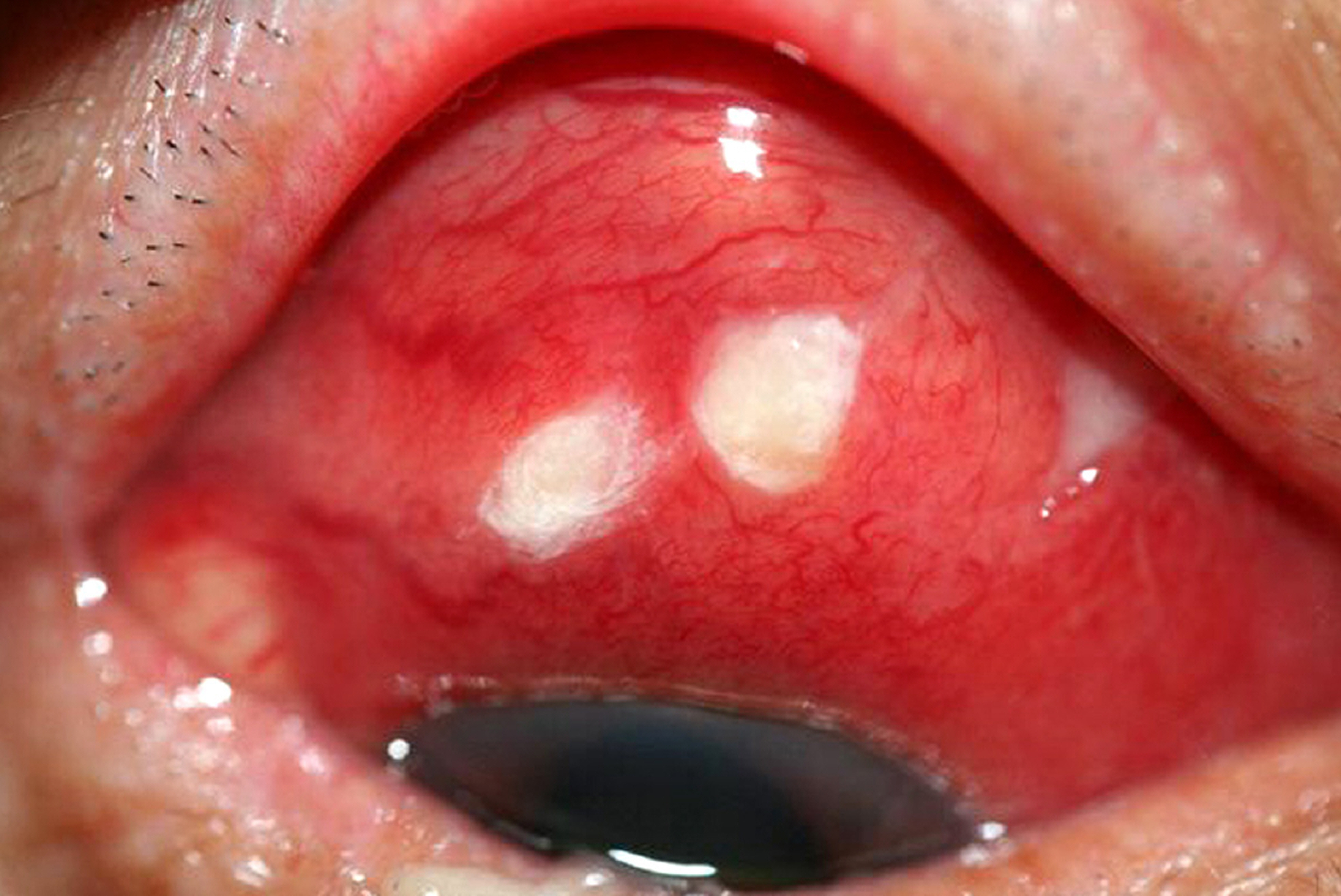J Korean Ophthalmol Soc.
2015 Oct;56(10):1646-1649. 10.3341/jkos.2015.56.10.1646.
A Case of Pseudomonas aeruginosa Infection after Scleral Buckling for Retinal Detachment
- Affiliations
-
- 1Department of Ophthalmology, Chungnam National University School of Medicine, Daejeon, Korea. youngjoon@cnu.ac.kr
- KMID: 2214429
- DOI: http://doi.org/10.3341/jkos.2015.56.10.1646
Abstract
- PURPOSE
To report a case of Pseudomonas aeruginosa infection after scleral buckling for retinal detachment.
CASE SUMMARY
A 68-year-old male presented with a 2-day history of pain in the right eye. The patient had a history of scleral buckling for retinal detachment 10 years earlier and excisional biopsy for conjunctival mass 1 month previously. Biopsy revealed chronic inflammation and granulation tissue formation. Slit-lamp examinations revealed superior conjunctival injection, edema and exposed suture knot. Fundus examination revealed exudative retinal detachment and choroidal detachment. The conjunctival lesion did not improve although the patient was treated with moxifloxacin. After 4 days, bacterial and fungal cultures were performed because the conjunctiva presented with purulent discharge 4 days after treatment. The scleral buckle and suture knot were removed. The cultures revealed growth of Pseudomonas aeruginosa. According to antibiotic sensitivity test results, the authors treated the patient with ceftazidime. The conjunctival lesion, choroidal detachment and exudative retinal detachment were improved.
CONCLUSIONS
In patients with conjunctival injection, edema, purulent discharge and ocular pain after scleral buckling, presence of infection should be suspected. If scleral buckle infection is suspected, bacterial culture, antibiotics treatment and scleral buckle removal should be considered.
MeSH Terms
Figure
Reference
-
References
1. D’Amico DJ. Clinical practice. Primary retinal detachment. N Engl J Med. 2008; 359:2346–54.2. Nishikiori N, Ohguro H. An intractable case of Pseudomonas aeru-ginosa infection after scleral buckling for rhegmatogenous retinal detachment. Clin Ophthalmol. 2008; 2:223–6.
Article3. Roldán-Pallarés M, del Castillo Sanz JL, Awad-El Susi S, Refojo MF. Long-term complications of silicone and hydrogel explants in retinal reattachment surgery. Arch Ophthalmol. 1999; 117:197–201.
Article4. Smiddy WE, Miller D, Flynn HW Jr. Scleral buckle removal fol-lowing retinal reattachment surgery: clinical and microbiologic aspects. Ophthalmic Surg. 1993; 24:440–5.
Article5. Deutsch J, Aggarwal RK, Eagling EM. Removal of scleral explant elements: a 10-year retrospective study. Eye (Lond). 1992; 6:(Pt 6). 570–3.
Article6. Pastor JC, Fernández I, Rodríguez de la Rúa E. . Surgical out-comes for primary rhegmatogenous retinal detachments in phakic and pseudophakic patients: the Retina 1 Project-report 2. Br J Ophthalmol. 2008; 92:378–82.
Article7. Sun Q, Sun T, Xu Y. . Primary vitrectomy versus scleral buck-ling for the treatment of rhegmatogenous retinal detachment: a meta-analysis of randomized controlled clinical trials. Curr Eye Res. 2012; 37:492–9.
Article8. Joseph J, Pathengay A, Michael V. . In vitro efficacy of cefazo-lin and povidone-iodine 5% in eradicating microbial organisms ad-hered to broad scleral buckles. Clin Experiment Ophthalmol. 2006; 34:390–1.
Article9. Tsui I. Scleral buckle removal: indications and outcomes. Surv Ophthalmol. 2012; 57:253–63.
Article10. Deokule S, Reginald A, Callear A. Scleral explant removal: the last decade. Eye (Lond). 2003; 17:697–700.
Article11. Holland SP, Pulido JS, Miller D. . Biofilm and scleral buckle- associated infections. A mechanism for persistence. Ophthalmology. 1991; 98:933–8.12. Mukkamala K, Gentile RC, Rao L, Sidoti PA. Recurrent hemo-lacria: a sign of scleral buckle infection. Retina. 2010; 30:1250–3.13. Hilton GF, Wallyn RH. The removal of scleral buckles. Arch Ophthalmol. 1978; 96:2061–3.
Article14. Ulrich RA, Burton TC. Infections following scleral buckling procedures. Arch Ophthalmol. 1974; 92:213–5.
Article15. Lindsey PS, Pierce LH, Welch RB. Removal of scleral buckling elements. Causes and complications. Arch Ophthalmol. 1983; 101:570–3.
- Full Text Links
- Actions
-
Cited
- CITED
-
- Close
- Share
- Similar articles
-
- Comparative Analysis of Scleral Buckling With or Without Postoperative Photocoagulation
- 12 Cases of Retinal detachmant by the scleral buckling procedure
- Delayed Absorption of Subretinal Fluid after Scleral Buckling Procedure for Rhegmatogenous Retinal Detachment
- A Case of Acquired Brown Syndrome Following Scleral Buckling
- Clinical Analysis of Laser Photocoagulation Following Scleral Buckling for the Treatment of Rhegmatogenous Retinal Detachment





